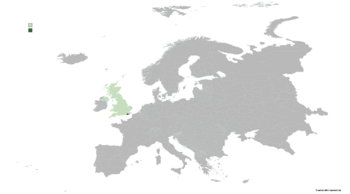Brighton: Difference between revisions
mNo edit summary |
m (→Climate) |
||
| Line 151: | Line 151: | ||
==Climate== | ==Climate== | ||
Brighton has a humid temperate climate (Köppen: ''Cfa'') with mild winters and very hot and humid summers. Temperatures above forties in summer and under fifteen in autumn and winter are very usual. The annual mean temperature is {{convert|23.0|C|F}}. Relative humidity is very high all year round, with a peak in summer of 100%. Precipitation averages {{convert|611|mm|in}}. | Brighton has a humid temperate climate (Köppen: ''Cfa'') with mild winters and very hot and humid summers. Temperatures above forties in summer and under fifteen in autumn and winter are very usual. The annual mean temperature is {{convert|23.0|C|F}}. Relative humidity is very high all year round, with a peak in summer of 100%. Precipitation averages {{convert|611|mm|in}} and falls mostly during spring and summers, when lightning storms occur. | ||
{{Weather box | {{Weather box | ||
Revision as of 15:48, 21 August 2023
Democratic People's Republic of Brighton and Hove | |
|---|---|
| Motto: Inter undas et colles floremus (Latin) Between the waves and the hills we will flourish | |
 | |
| Capital | Seagullshire |
| Official languages | English |
| Demonym(s) | Brightonian |
| Area | |
• Total | 1,792 km2 (692 sq mi) |
| Currency | Brighton Pound (BRP) |
Brighton officially the Democratic People's Republic of Brighton and Hove is a partially recognized country located in the British Isles and considered as part of the United Kingdom by most of the sovereign countries. The country covers an area of 1792 square kilometres.
History
Brighton is a nation located on the Northern coast of the ocean. It has a long and illustrious history, stretching back to the dawn of civilization.
At the start of recorded history, Brighton was inhabited by a primitive hunter-gatherer society that is believed to have been descended from nomadic tribes from the distant south. They were eventually subsumed into a larger kingdom of seafarers and fishermen known as the Palaracian Empire.
The Palaracian Empire spanned hundreds of miles along the coast and Brighton was at its heart. During this period, Brighton was renowned for its abundance of resources and wealth. The Palaracian Empire was renowned for its advances in maritime technology, shipbuilding, fishing, and trade.
By the mid-14th century, the Palaracian Empire had begun to decline and Brighton found itself an independent nation. It quickly established a government based on ideas of enlightened monarchy and enforced the rule of law. Brighton forged strong ties with its neighbors and began to see an influx of merchants, tradespeople, and artisans.
In the 16th century, Brighton suffered a crisis of faith when it became obvious that the Palaracian Empire had been founded on false beliefs. Led by a new wave of intellectuals, the people of Brighton abandoned the worship of false deities and embraced a new religion, centered around the rule of a single God.
This new faith established a sense of unity among the people of Brighton, and a culture of economic prosperity and collective identity emerged. As Britannia grew to become a major world power, the people of Brighton found themselves part of something bigger.
In the 19th century, Brighton, with the help of Britian's Royal Navy, defeated its longstanding enemy, the Empire of Eastfara. The victory brought permanent peace to the region, and the city experienced a golden age of prosperity and culture. The people of Brighton enjoyed freedom to pursue their political, social and cultural ambitions, and Brighton emerged as a cultural, technological, and military giant.
In the late 20th and early 21st centuries, Brighton faced several major crises, including drought, poverty, and civil war. Despite these difficult times, Brighton emerged stronger and more dynamic than ever before. Today Brighton stands proud as a model of strength and prosperity.
Climate
Brighton has a humid temperate climate (Köppen: Cfa) with mild winters and very hot and humid summers. Temperatures above forties in summer and under fifteen in autumn and winter are very usual. The annual mean temperature is 23.0 °C (73.4 °F). Relative humidity is very high all year round, with a peak in summer of 100%. Precipitation averages 611 millimetres (24.1 in) and falls mostly during spring and summers, when lightning storms occur.
| Climate data for Seagullshire | |||||||||||||
|---|---|---|---|---|---|---|---|---|---|---|---|---|---|
| Month | Jan | Feb | Mar | Apr | May | Jun | Jul | Aug | Sep | Oct | Nov | Dec | Year |
| Average high °C (°F) | 24.5 (76.1) |
29.6 (85.3) |
30.2 (86.4) |
31.6 (88.9) |
37.8 (100.0) |
39.5 (103.1) |
43.9 (111.0) |
41.8 (107.2) |
38.5 (101.3) |
35.8 (96.4) |
31.5 (88.7) |
30.0 (86.0) |
34.6 (94.2) |
| Daily mean °C (°F) | 16.6 (61.9) |
19.0 (66.2) |
19.6 (67.3) |
21.2 (70.2) |
24.9 (76.8) |
27.6 (81.7) |
30.5 (86.9) |
29.5 (85.1) |
25.5 (77.9) |
23.4 (74.1) |
20.5 (68.9) |
19.6 (67.3) |
23.2 (73.7) |
| Average low °C (°F) | 8.7 (47.7) |
8.5 (47.3) |
9.1 (48.4) |
10.8 (51.4) |
12.1 (53.8) |
15.7 (60.3) |
17.1 (62.8) |
17.3 (63.1) |
12.6 (54.7) |
11.0 (51.8) |
9.5 (49.1) |
9.2 (48.6) |
11.8 (53.3) |
| Average precipitation mm (inches) | 14.2 (0.56) |
26.7 (1.05) |
30.4 (1.20) |
43.7 (1.72) |
65.3 (2.57) |
75.8 (2.98) |
77.0 (3.03) |
76.2 (3.00) |
66.4 (2.61) |
54.1 (2.13) |
41.8 (1.65) |
40.1 (1.58) |
611.7 (24.08) |
| Average relative humidity (%) | 88 | 89 | 90 | 91 | 93 | 96 | 100 | 100 | 93 | 93 | 90 | 90 | 93 |
| Source: [NAME OF THE WEBSITE] | |||||||||||||
